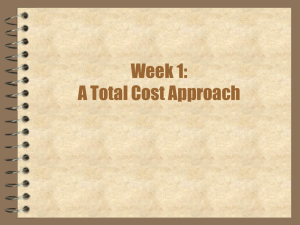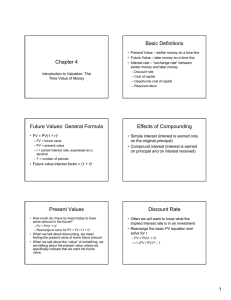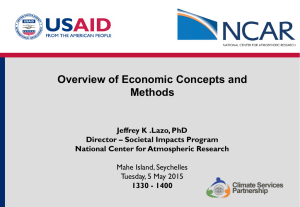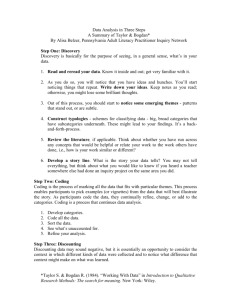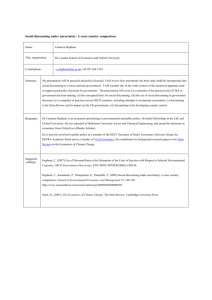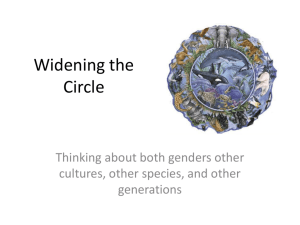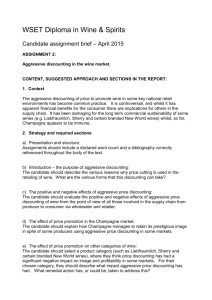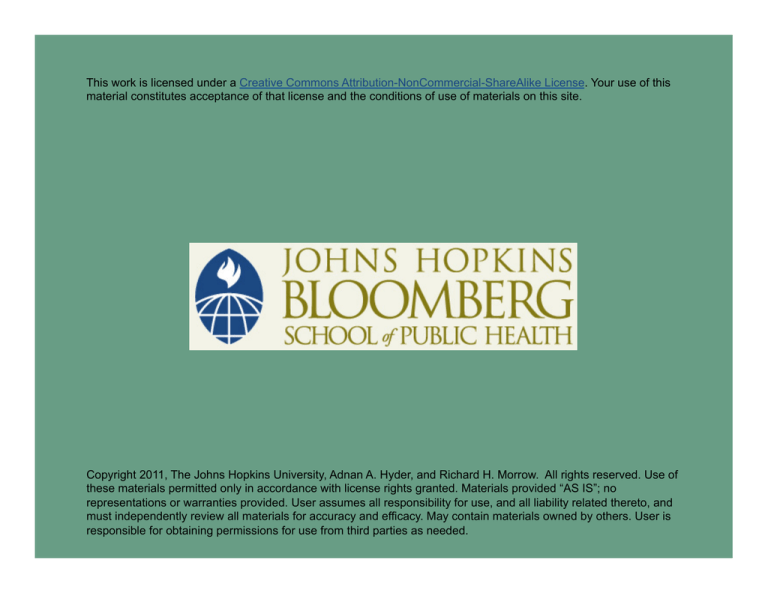
This work is licensed under a Creative Commons Attribution-NonCommercial-ShareAlike License. Your use of this
material constitutes acceptance of that license and the conditions of use of materials on this site.
Copyright 2011, The Johns Hopkins University, Adnan A. Hyder, and Richard H. Morrow. All rights reserved. Use of
these materials permitted only in accordance with license rights granted. Materials provided “AS IS”; no
representations or warranties provided. User assumes all responsibility for use, and all liability related thereto, and
must independently review all materials for accuracy and efficacy. May contain materials owned by others. User is
responsible for obtaining permissions for use from third parties as needed.
Social and Ethical Value Choices
Richard H. Morrow, MD, MPH
Adnan A. Hyder, MD, PhD, MPH
Johns Hopkins University
Section A: Discounting: Valuing Future Life
Richard H. Morrow, MD, MPH
Johns Hopkins University
Learning Objectives
Define discounting
Demonstrate how to convert expected future earnings to their
present value
Explain the rationale for applying discounting to healthy life
expected to be gained (e.g., from immunization) in the future
Compare and contrast with the rationale for not discounting future
healthy life
Distinguish the effects of discounting future life from those of life
expectation
4
Outline of Presentation
Context of setting priorities in health
Valuing health and life
Valuing future life
- Discounting
Valuing life at each age
- Age weighting
Valuing economic and social productivity
Valuing equity in relation to efficiency
Discussion
5
Five Steps in Setting Priorities
The Five Steps
1. Measure impact of disease
2. Calculate gains in healthy life for all relevant health
interventions
3. Develop unit costs for these interventions
4. Work out optimum benefit /cost ratio
5. Ensure fair distribution
But how do we value the healthy life?
6
The Sixth Step
The dollar value of healthy life—needed to compare resources used
for health with their use for anything else
Approaches
- Productivity—average or marginal wage
- Human capital approach—pioneered by Gunnar Myrdal
- WTP—willingness to pay
Jeffrey Sachs—(Commission on Macroeconomics and Health) 2X + per
capita GNI
Cost-effectiveness analysis—λ, the decision maker’s WTP for the last
intervention on the list of a league table
Value of a statistical life—review of legislative decisions of safety
regulations: $50,000 to $2,000,000,000 per life saved
7
Valuing Components
Valuing future life as compared to present life
- Discounting present value of future life
Valuing a given duration of life
- Life lived at different ages
- Age weighting
Valuing economic and social productivity
Valuing equity in relation to efficiency
8
Discounting
Deducting
Offering at reduced rate
Reducing the usual list price
Leaving out of account; disregarding
Taking into account in advance (so as to diminish the effect of …)
Advancing or lending money after deduction of interest
9
Discounting
The present value (pv) of a future amount of money is the amount
of money, invested now at r percent interest, that will grow to the
future value at the stated time
The future value (fv) = pv*(1+r)n
- Where n = number of interest periods (usually years) and
- r = interest rate
- pv = (fv in n years) / (1+r)n
- Note that 1/(1+r)n = e-r n when continuously compounded
It may be considered the inverse of interest rate
10
Discounting
The pv = (fv in n years) / (1+r)n
- E.g., if the interest rate is 10%, $100 to be received 10 years
from now, has a pv of $38.55
- If r = 3%, then pv = $74.41
Discounting is standard practice in financing/economics
11
Discounting
In the use of composite measures of disease burden, expected years
of healthy life in the future are commonly discounted
Present value of a year of healthy life in the future discounted
Years hence
At 3% per year
At 8% per year
1
0.97
0.92
10
0.744
0.463
30
0.412
0.099
50
0.228
0.021
12
Discounting
For example, the gains of healthy life per 1000 population per year
from measles immunization in Ghana was 26.89 discounted healthy
life years (given the population structure and conditions in Ghana as
in the Excel spreadsheet from Ghana)
If not discounted, the gains would be 86.99 healthy life years—a
very large difference. The size of the effect depends on both the
expectation of life (the future years) and on the discount rate.
13
The Impact of Different Discount Rates
The impact of different discount rates on HeaLY losses in Pakistan
Disease
0%
+1%
+3%
+6%
+9%
Injuries
68.7
45.2
31.9
21.1
15.2
Childhood anemia
29.9
15.9
10.7
7.6
6.2
LTRI-child
147.0
66.0
36.8
20.7
14.4
LTRI-adult
10.5
8.3
6.8
5.1
4.0
Heart disease
37.6
28.0
21.4
15.2
11.3
151.3
68.6
38.9
22.7
16.4
1233.3
690.0
456.3
298.5
223.0
Diarrhea
Total
Source: Hyder and Morrow. (1998).
14
Factors Underlying Discounting
The RTP—rate of time preference
- In general, people prefer to have things now
Diminishing marginal utility
- OK for income—but what about life?
Risk aversion
- But uncertainty may better be dealt with separately and is not
intrinsic to discounting
Time myopia
-
-
An impatience to experience pleasure
Individual vs. society
15
Factors Underlying Discounting
The RTP—rate of time preference
- In general, people prefer to have things now
- Caution: In my early efforts to explain discounting, I asked,
“Would you rather have 10 years of healthy life starting now or
starting 20 years from now?”
Diminishing marginal utility
- OK for income—but what about life?
Risk aversion
- But uncertainty may better be dealt with separately and is not
intrinsic to discounting
Time myopia
- An impatience to experience pleasure
- Individual vs. society
16
Issues in Discounting
The disease eradication/health research paradox, “the only strong
argument for discounting”
- If r = 0 (no discount rate), future healthy life lost would be just
as valuable as present healthy life lost
- Then take resources from the present and invest them to
develop prevention or cure in the future
- Thus stop all current health care and put all such resources into
better interventions for the future?
Only discounting saves us from this logic
- Think about this. Do you agree?
17
Issues in Discounting
Club of Rome and future generations
- Discounting: “the greatest evil ever perpetrated by economists”
Intergenerational equity issues
What rate of discount?
Should life itself be discounted? Or the products of life (what that
life produces)?
-
Life itself or what one does with that life?
18


